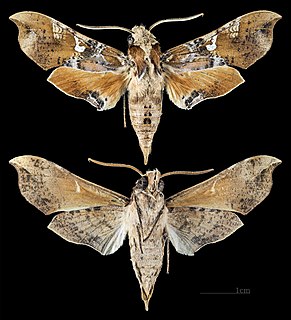
The gray bat is a species of microbat endemic to North America. The creature once flourished in caves all over the southeastern United States, but due to human disturbance, gray bat populations declined severely during the early and mid portion of the 20th century. At one cave alone, the Georgetown Cave in northwestern Alabama, populations declined from 150,000 gray bats to 10,000 by 1969. 95% of gray bats now only roost in 9 caves. M. grisescens has been listed as federally endangered by the U.S. Fish and Wildlife Service since 1976, and is protected under the Endangered Species Act. Gray bat populations were estimated at approximately 2 million bats around the time they were placed on the Endangered Species list. By the early 1980s populations of gray bats dropped to 1.6 million. With conservation efforts in place, in 2002, gray bat populations were estimated to have reached 2.3 million.

Callionima is a genus of moths in the family Sphingidae first described by Hippolyte Lucas in 1857.

Byturidae, also known as Fruitworms, is a very small family of beetles, in the suborder Polyphaga, comprising fewer than 20 species worldwide. The larvae of some species develop in fruits. Byturus unicolor affects species of Rubus and Geum.

Epipsilia grisescens is a moth of the family Noctuidae. It is found in Fennoscandia, Denmark as well as the Pyrenees, Alps, Apennines, Balkans and Carpathians. In the Alps it is found up to 2,000 meters.

Callionima grisescens is a species of moth in the family Sphingidae, which is known from Argentina, Paraguay, Bolivia and Brazil. It was originally described by Rothschild as Calliomma grisescens, in 1894.
Apisa grisescens is a moth of the family Erebidae. It was described by Abel Dufrane in 1945. It is found in the Democratic Republic of the Congo, Malawi, Mozambique and Zimbabwe.
Episcepsis grisescens is a moth of the family Erebidae. It was described by George Hampson in 1914. It is found in Venezuela.

Sybra is a genus of beetles in the family Cerambycidae, containing the following species:
Mimagelasta grisescens is a species of beetle in the family Cerambycidae, and the only species in the genus Mimagelasta. It was described by Stephan von Breuning in 1939.
Celiptera grisescens is a moth of the family Erebidae. It is found in Mexico (Veracruz).

Sybra umbratica is a species of beetle in the family Cerambycidae. It was described by Pascoe in 1865.
Sybra uenoi is a species of beetle in the family Cerambycidae. It was described by Hayashi in 1956. It is known from Japan.
Sybra bioculata is a species of beetle in the family Cerambycidae. It was described by Pic in 1925. It contains four subspecies: Sybra bioculata bioculata, Sybra bioculata quadrinotata, Sybra bioculata sikkimana, and Sybra bioculata tigrina.

Sybra ordinata is a species of beetle in the family Cerambycidae. It was described by Bates in 1873.
Sybra pascoei is a species of beetle in the family Cerambycidae. It was described by Lameere in 1893.
Sybra subfasciata is a species of beetle in the family Cerambycidae. It was described by Bates in 1884.
Nonyma grisescens is a species of beetle in the family Cerambycidae. It was described by Breuning in 1969.
Xerasia grisescens is a species of fruitworm beetle in the family Byturidae. It is found in North America.
Lejops grisescens is a species of syrphid fly in the family Syrphidae.

Dinera grisescens is a species of bristle fly in the family Tachinidae. It is found in North America.











